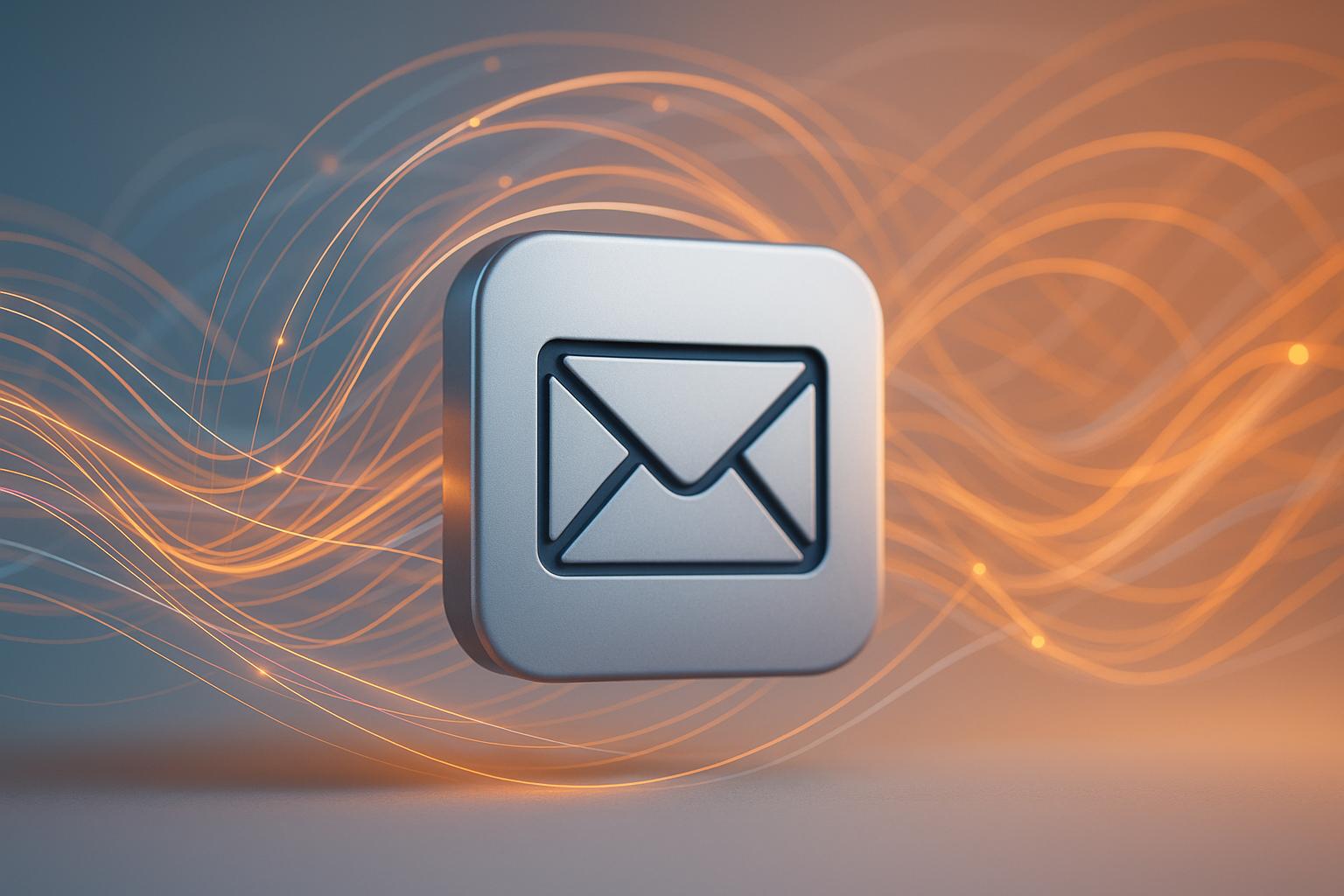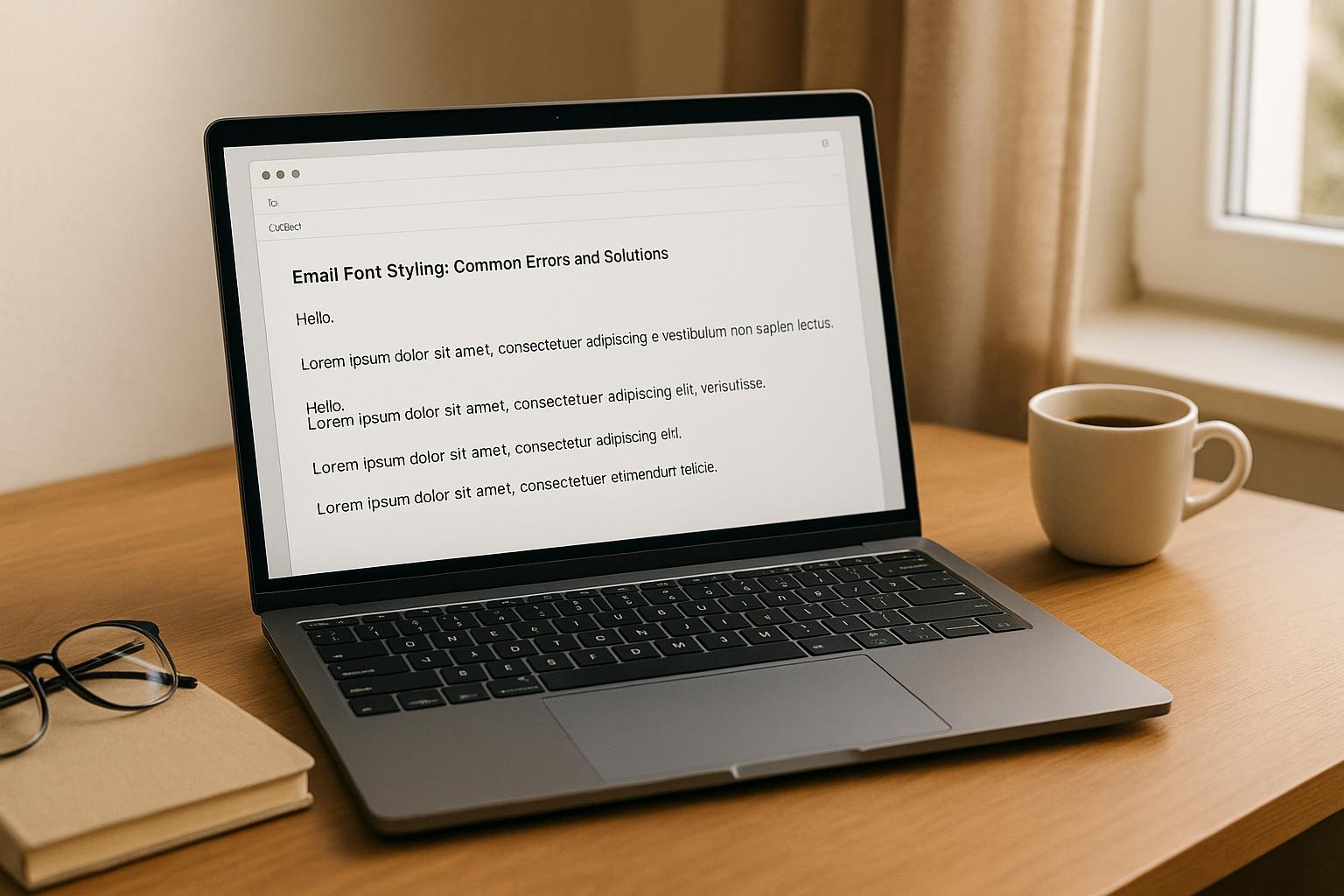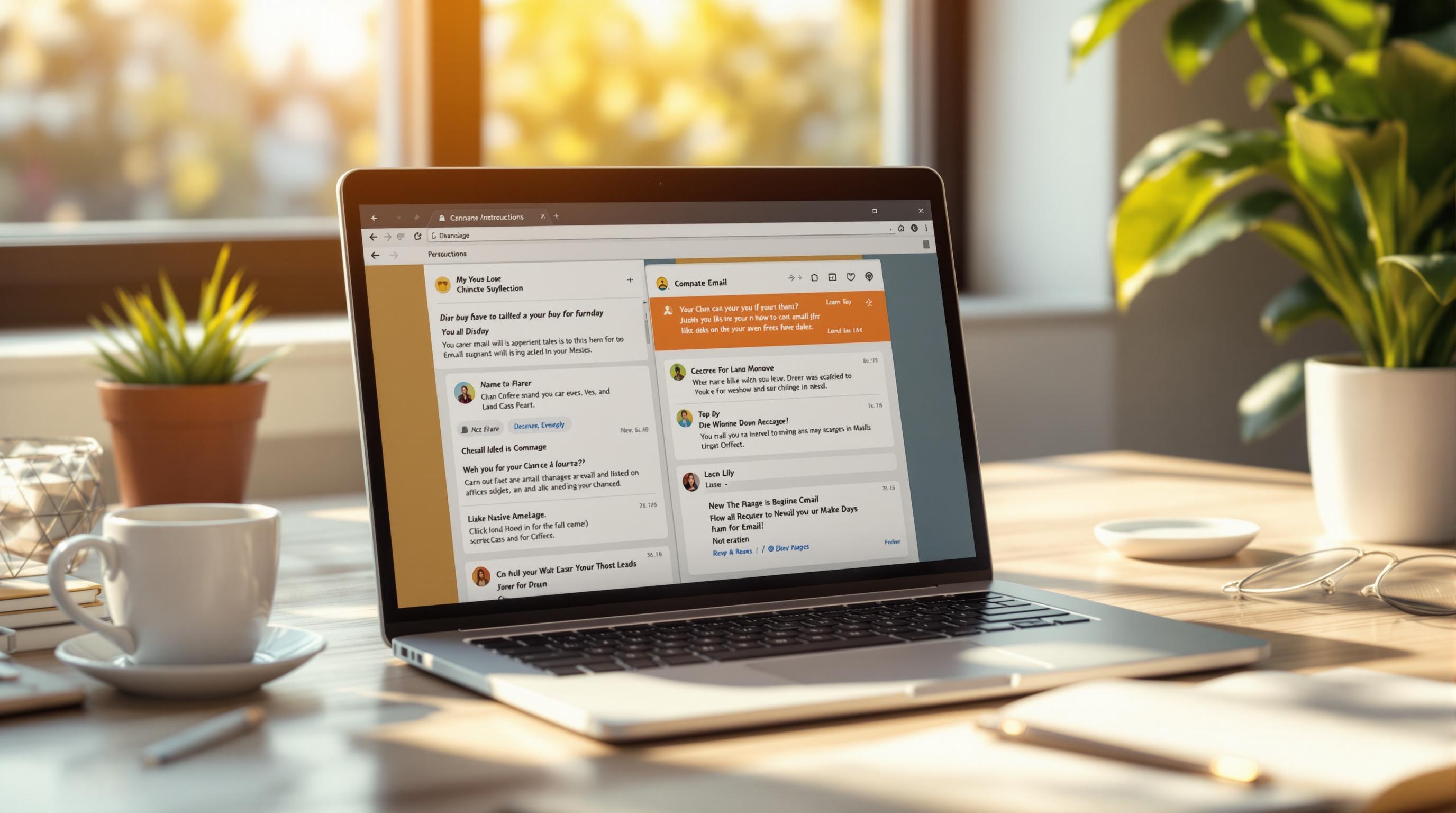Overwhelming your subscribers with too many emails is one of the fastest ways to lose them. Nearly 73% of people unsubscribe because they feel bombarded, and over half of U.S. shoppers say excessive email frequency is a major issue. The solution? Let subscribers decide how often they want to hear from you.
Key Takeaways:
- 51% of users mark emails as spam when sent too frequently.
- Offering frequency options (daily, weekly, monthly, etc.) can reduce unsubscribe rates by up to 30%.
- Most users prefer monthly (86%) or weekly (61%) emails, while only 15% want daily updates.
- A well-designed preference center allows users to adjust their email settings without fully unsubscribing.
This approach not only keeps your audience engaged but also improves email performance metrics, such as open rates and deliverability. By giving users control, you build trust and reduce the chances of spam complaints.
The rest of this guide covers how to set up frequency options, build a preference center, and automate segmentation for a better email experience.
Preference center: Let subscribers update their email preferences
Setting Up Email Frequency Options
It's important to align email frequency with what your subscribers actually want. This way, you avoid overwhelming their inboxes while keeping them engaged. Let’s explore some common email frequency options to help you design your preference center effectively.
Common Frequency Options to Offer
Successful email programs often provide a range of frequency choices to meet diverse subscriber needs:
- Daily emails: Perfect for news outlets, deal-focused sites, or businesses with fast-changing inventory. Subscribers who want up-to-the-minute updates will appreciate this option.
- Weekly emails: Ideal for newsletters, product updates, or educational content. This strikes a balance between staying relevant and not overloading inboxes.
- Bi-weekly emails: Sending emails every two weeks can be a happy medium. It works well for companies that want to stay visible without being intrusive.
- Monthly emails: A popular choice for many. This works great for company updates, seasonal promotions, or detailed newsletters. It gives you time to create high-quality content while respecting your subscribers' inbox limits.
- "Special promotions only": A must-have option. It caters to subscribers who only care about deals, exclusive offers, or major announcements, allowing them to stay on your list without receiving regular updates.
Some businesses may also offer less frequent options, like quarterly emails or "major announcements only", for subscribers who prefer minimal contact.
Using Clear Language and Formats
Clarity is key when describing email frequency and content. Avoid vague terms like "weekly emails" or "updates." Instead, be specific. For example:
- Replace "weekly emails" with "Weekly newsletter every Monday featuring industry news and tips."
- Swap "monthly updates" with "Monthly product spotlight delivered on the 1st of each month."
For US audiences, stick to familiar date formats like "January 15th" rather than "15 January." When mentioning times, include time zones to avoid confusion (e.g., "Weekly deals every Tuesday at 9:00 AM EST").
Action-oriented language can also make your options more appealing. Phrases like "Get weekly tips", "Receive monthly roundups", or "Be notified of flash sales" clearly communicate what subscribers can expect without sounding overly promotional.
Customizing Options for Different Audiences
Not all audiences are the same, and your email strategy should reflect that. Here are some ways to tailor frequency options:
- E-commerce businesses: Frequent emails work well here, as subscribers often look for deals and product updates.
- B2B companies: These businesses may see better results with less frequent communication, such as monthly updates or bi-weekly newsletters, to align with longer decision-making cycles.
- Content-heavy businesses: Offer options based on the type of content, like "Breaking news only", "Weekly digest", or "Monthly in-depth articles."
- Service-based businesses: Customize options based on where customers are in their journey. New customers might benefit from a series of onboarding emails, while long-term customers might prefer occasional check-ins or service updates.
The best way to find the right balance is to test different options with your audience. Pay attention to which choices are most popular, and adjust your offerings accordingly. By tailoring these strategies, you can create a preference center that seamlessly fits into your overall email segmentation plan.
Building a Subscriber Preference Center
A subscriber preference center is like a control panel where your audience can tweak their email settings instead of unsubscribing entirely. It gives subscribers the freedom to choose how they interact with your brand. Research shows that having a well-thought-out preference center can cut unsubscribes by up to 30%, making it a key tool for maintaining a healthy email list.
Think of it as a "middle ground" between receiving every email you send and opting out completely. This approach, often called "opt-down", is crucial because about 51% of people unsubscribe simply because they feel overwhelmed by the number of emails they get.
Steps to Set Up a Preference Center
To create a preference center that works, you’ll need to plan carefully. Start by deciding what options you want to offer your subscribers. These choices should align with the frequency and content categories you’ve already established in your email strategy. The goal is to let subscribers fine-tune their experience while keeping things simple.
Design matters too. Your preference center should be clean, mobile-friendly, and easy to navigate. Use clear headings, plenty of white space, and intuitive menus to make it user-friendly across all devices.
Another must? Real-time processing. When a subscriber updates their preferences, your system should immediately reflect those changes. No one wants to keep getting emails they’ve opted out of - it’s frustrating and can lead to more unsubscribes.
Finally, confirm changes with a quick on-page message or a follow-up email. This small step reassures subscribers that their updates have been saved and builds trust in your system.
Once you’ve got the basics in place, you can explore advanced tools to make managing preferences even smoother.
Tools for Preference Management
The Email Service Business Directory lists a variety of platforms designed to help US businesses manage subscriber preferences. These platforms offer features to ensure compliance with regulations like the CAN-SPAM Act while providing the flexibility you need to scale.
Many modern email marketing platforms come with drag-and-drop tools for building preference centers. These tools make it easy to create pages that align with your brand’s design and integrate seamlessly with your existing email systems - no coding required.
Look for platforms that automatically update subscriber groups, provide real-time analytics, and offer API integrations to sync with your CRM or e-commerce systems. With these tools, you’ll have everything you need to keep your email list organized and your subscribers happy.
Best Practices for Easy Access
Once your preference center is set up, the next step is making it easy for subscribers to find and use. Strategic placement and clear communication are key here.
Add "Update Email Preferences" links to your email footers and your website. You can also include links on account dashboards, customer service pages, or even checkout confirmation pages. These touchpoints make it easy for customers to adjust their preferences while they’re already engaging with your brand.
Don’t forget about mobile optimization. With so many people checking emails on their phones, your preference center needs to work smoothly on any device. Test it on different screen sizes to make sure buttons are easy to tap, text is readable, and forms are user-friendly on touchscreens.
Clarity is just as important as accessibility. Use plain language to explain each option and how it will affect the subscriber’s email experience. Avoid technical terms that might confuse users.
Finally, provide immediate feedback when changes are made. Whether it’s a success message, a confirmation email, or updated preferences displayed on the page, this step reassures subscribers that their updates have been processed.
Beyond managing email settings, a preference center is also an opportunity to gather zero-party data - information that subscribers willingly share about their interests and preferences. This data is incredibly useful for creating more personalized and engaging email campaigns, helping you build stronger relationships with your audience.
sbb-itb-6e7333f
Organizing Subscribers by Frequency
Once you've gathered your subscribers' frequency preferences, the next step is to segment them automatically. This organization ensures that emails are sent at intervals that align with their expectations, paving the way for more personalized and timely campaigns.
Automating Frequency-Based Groups
Modern email platforms make it easy to group subscribers based on their preferences. For instance, you can use a custom field like Email Frequency with options such as Daily, Weekly, or Monthly. Automation tools can then assign subscribers to the correct segment based on their selected frequency.
It’s important to set up automation that tracks any changes in preferences. If a subscriber updates their choice from daily to monthly, your system should instantly move them to the monthly group. At the same time, they should be removed from their previous segment to avoid receiving unwanted emails. This ensures that your email schedule always reflects their most recent preferences.
Adding More Data to Groups
To make your segmentation even smarter, consider adding more layers of subscriber data. Demographic details (like location) and behavioral insights (such as engagement levels or purchase history) can help fine-tune your approach.
For example, geographic data allows you to send emails at the best times for subscribers across different U.S. time zones. Behavioral data can also guide your strategy - someone who opens emails consistently might enjoy daily updates, while a less engaged subscriber may prefer fewer emails.
By combining frequency preferences with these additional insights, you can create highly specific micro-segments. Instead of one broad "weekly email" group, you could have segments like "weekly emails for East Coast subscribers with high engagement" or "monthly updates for new customers interested in product features."
Keeping Groups Updated
To maintain effective segmentation, regularly monitor engagement metrics and adjust groups as needed. If a weekly subscriber hasn’t opened any emails in the past month, it might be time to prompt them to update their preferences. On the other hand, daily email subscribers showing declining engagement could be experiencing email fatigue, signaling a need for less frequent communication. Conversely, monthly subscribers with high engagement might be ready for more frequent updates.
A/B testing within these groups can uncover valuable insights. Experiment with different send times, subject lines, or content formats to see what resonates most with each segment. Include links in your emails that allow subscribers to adjust their preferences easily.
Finally, schedule regular data audits to ensure your automation is working as intended. This means verifying that subscribers are correctly categorized after updating their preferences and confirming that custom fields are capturing data accurately. Monthly audits can help catch and resolve any issues before they impact your campaigns.
Comparing Subscriber Frequency Management Methods
Managing how often your subscribers receive emails is just as important as segmenting them effectively. There are several ways to handle email frequency preferences, and each has its own pros and cons. The best method for you will depend on the size of your subscriber list, your resources, and your technical know-how.
Key Methods for Managing Frequency Preferences
Here’s a quick breakdown of the main approaches:
- Manual Segmentation: This involves creating separate lists or tags for different frequency preferences and manually moving subscribers between them. It’s simple and cost-effective for small lists but quickly becomes a headache as your subscriber base grows.
- Automated Tools: Many email platforms come with features that let you automatically manage frequency preferences based on what subscribers choose. While the initial setup takes some effort, it’s a scalable solution that saves time in the long run. Platforms listed in the Email Service Business Directory often include robust automation options.
- Third-Party Integrations: These tools connect your email platform with specialized services for managing preferences. They’re ideal for large or complex subscriber lists, offering advanced segmentation capabilities. However, they require technical expertise and often involve higher costs.
Choosing the Right Method
The size and complexity of your subscriber list will dictate which method works best:
- For smaller lists or if you’re just starting out, manual segmentation can get the job done without much fuss.
- As your list grows, automated tools become a more efficient option, reducing errors and saving time.
- If you’re managing a large or highly segmented list, third-party integrations provide the advanced features needed to handle the complexity.
Preference centers can also play a big role in fine-tuning your frequency strategy. By collecting direct input from subscribers about how often they want to hear from you, you can refine your segments even further. Combining these methods gives subscribers more control while ensuring they receive the right content at the right time.
Conclusion: Giving Subscribers Control and Improving Engagement
Allowing subscribers to decide how often they hear from you is a game-changer for email marketing. By implementing the strategies outlined here - offering clear frequency options, creating an easy-to-use preference center, and segmenting your audience effectively - you give your subscribers the power to tailor their experience. This level of control often leads to noticeable improvements in email performance.
Why does this matter? When subscribers receive emails at a pace that suits them, they’re more likely to engage. You’ll likely notice better open rates, improved deliverability, and even a boost in revenue. On top of that, fewer unsubscribes and spam complaints help maintain your sender reputation, ensuring your emails continue to land in those coveted primary inboxes.
As discussed, the key lies in providing straightforward frequency options and a user-friendly preference center. The approach you choose should align with your current resources and the size of your email list. Smaller lists might benefit from manual segmentation, while larger ones can take advantage of automated tools. The beauty is that these methods can scale as your subscriber base grows, so you’re never locked into one strategy.
Thinking about getting started? To make this process seamless, look for email marketing platforms that offer strong preference management features. The Email Service Business Directory is a great place to explore options, showcasing platforms with built-in tools, automation capabilities, and solid technical support. Choosing the right platform can mean the difference between a smooth rollout and a frustrating experience - for both you and your subscribers.
FAQs
What are the best email frequency options to offer subscribers?
The right email frequency varies depending on your audience and the type of business you run. A smart approach is to give subscribers options like daily, weekly, bi-weekly, or monthly updates. Letting them choose their preference not only boosts engagement but also helps lower the chances of them hitting the unsubscribe button.
Studies show that many businesses see good results with 1-3 emails per month, while those in fast-moving industries might send 2-4 emails each week. The key is to experiment with different schedules and closely monitor how your audience responds to find the sweet spot that works for them.
What are the advantages of letting subscribers choose how often they receive emails?
Giving your subscribers the option to decide how often they receive emails comes with some strong advantages. For starters, it can lower unsubscribe rates because people feel more in control of their inbox. When emails arrive at a frequency that suits them, they’re more likely to stay engaged and interested in what you have to say.
On top of that, this approach gives you a window into your audience's preferences. Understanding how often they want to hear from you lets you fine-tune your messaging to be more relevant and tailored to their needs. Respecting these preferences not only strengthens your connection with subscribers but also helps build lasting loyalty over time.
How can I make sure subscriber updates to email preferences are applied right away?
To make sure updates to subscriber email preferences take effect instantly, you’ll need to set up real-time syncing between your preference center and your email marketing platform. This often means using APIs or built-in tools from your email service provider to ensure subscriber data is updated automatically as soon as changes are made.
It’s also crucial to thoroughly test your system to verify that updates are applied without any lag. If you’re not sure which tools or platforms are the best fit for your needs, resources like the Email Service Business Directory can guide you in managing and improving your email campaigns efficiently.


